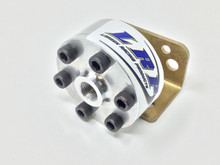So just noticed this so I’m sorry if it seems a bit rude to push in.
1.) proportioning is accomplished by the master cylinder. The block on the frame in front and the axle in back is distribution only.
2.) every “disc upgrade” that uses the 10x2 1/2 rears adds more rear brake. So for a car that had to much rear with the 10 x 1 3/4, you just made more problems.
3.) switch in the block indicates an imbalance in the system.
Brake warning light on dash
As others pointed out the balance valve can cause the light as well as air and improperly adjusted rear brakes.
First be sure your bleed is good. Stab the brakes hard three to five times and hold down the peddle on the last stab. Open the brake bleeder. Rinse and repeat on all four wheels. This bleed method shocks the system to release bubbles as well as dislodge any jammed balance valve. After that bleed, and properly adjusting the rears, if you still have a light, the block is faulty.
Now after you have fixed the light, you can address the rear bias. You can go back to the 10x1 3/4 rear to get less brake or put an inline valve to back off the rear.
I don’t like the valve solution as it gives you a much harder peddle feel. It is the one most guys use.
To get big bolt pattern on the rear with smaller drums, use the A body backing plate with a B body six drum. I’ve bought AMC drums to see if that works as well but haven’t been able to get one put together


















